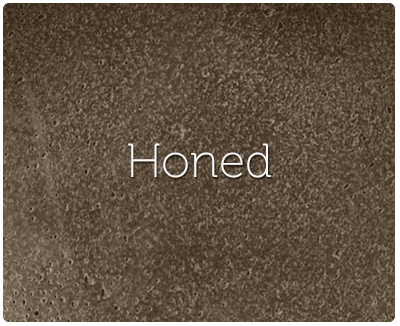Marble, Limestone, Granite, Slate, Soapstone, Onyx, Travertine
Appearance
Honed surfaces differ from polished surfaces in that they reflect far less light. These finishes are often described as “matt” finishes, or just “dull.”
Some Things to Keep In Mind
- The fact that comparatively less light is reflected back at one’s eye means that less of the detail of the stone is immediately apparent.
- This can be very advantageous in stones that are either easily etched, or have very busy patterns.
- Honing can be done to varying degrees as well:
- Some “nearly-shiny” surfaces are called “high-honed” while at the other extreme, surfaces can be made to feel course to the touch.
- Honing may be chosen for aesthetic reasons or practical reasons so that ongoing care can be better managed.

Marble, Limestone, Granite, Slate, Soapstone, Onyx, Travertine
When stone is honed, it is generally somewhat more porous than its polished equivalent, so it should be sealed more often than a polished surface. Still, honed marbles, limestones, and travertines are actually easier to take care of in many cases than are polished versions of the same stones.
- This is entirely a matter of perception in that since there is comparatively little light reflected from a honed surface, etchings and scratches are less visible. This is often pleasing to the homeowner who then waits longer between visits from the stone expert to remove those irregularities.
Care and Cleaning Tips
Honed surfaces may be more susceptible to discoloration from foods than are polished surfaces.
- Neutral pH cleaners need to be used frequently to remove residue from the surface that may otherwise make its way below the surface.
- Discolorations can often be “lifted” from the stone with poultices and other specialty products. After doing so, resealing should be performed.
- The level of honed finish can be altered professionally. In the process of resealing, it is sometimes worth exploring a marginal change in the level of finish in order to satisfy aesthetic desires or practical requirements.
- Slate and soapstone will always have a rough or honed finish. Slate needs to be resealed periodically to maintain the integrity of the surface.
- Flaking and surface chipping is common in slate since it is a layered stone. Allowing the stone to dry out encourages that flaking. Frequent resealing, using a color enhancing sealer (if available) – can help retain the original surface as well as its color.
- Soapstone is maintained by the frequent application of mineral oil. Spreading the oil on and allowing it to be absorbed by the stone keeps the stone from becoming brittle. Soapstone is so porous that sealers have no effect on it. Again, neutral pH cleaners should be used for all of these natural stone surfaces.
Granite Care and Cleaning Tips
- Annual sealing of the granite will fill the pores of the stone with a substance that will generally reject water and other household liquids.
- Resealing is done periodically due to the evaporation of the sealer and the eventual breakdown of its solid components.
- Routine (daily) cleaning should be done with a neutral pH cleaner.
- Keeping the surface dry after use will help extend the life of the sealer as well.

